 I’ve already stated that the best book covers DO persuade me and make a difference in whether or not I’ll purchase a title. What I didn’t relate is that dust jacket and book covers are a passion of mine. I love illustration on practically anything; from packaging perfumes, to ads, to menus, and naturally books. The best examples of spectacular book covers are from the past–the 1920s through the 1940s. I’ve written a couple of articles about standout book covers, one dealing with the 1930 publisher Mystery League and their entire output dressed in Dec
I’ve already stated that the best book covers DO persuade me and make a difference in whether or not I’ll purchase a title. What I didn’t relate is that dust jacket and book covers are a passion of mine. I love illustration on practically anything; from packaging perfumes, to ads, to menus, and naturally books. The best examples of spectacular book covers are from the past–the 1920s through the 1940s. I’ve written a couple of articles about standout book covers, one dealing with the 1930 publisher Mystery League and their entire output dressed in Dec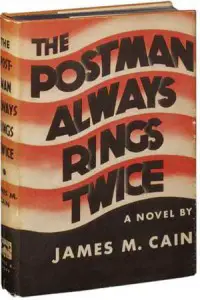 o covers. Doubleday Crime Clubs artists created some the best covers with an extra plus–Doubleday Crime Club adorned the front board and spine with similar art to the jacket– during a short period in the 1930s. As the 1940s rolled in, the pulp paperback trade depended on their artists to come up with the best covers to entice a reader, especially the male ones, even if the interior story-line didn’t match what the cover promised. Golden Age children’s books may have had dust jackets, but most are long gone. However, sometimes they had the same illustration on the front board of the book, and therefore the book cover would take on the dust jacket’s job. Most books today have no art on the boards. Fiction during the 20s, 30s, 40s had some stylistically and iconic dust jackets. The Postman Always Rings Twice, created by book cover artist, Arthur Hawkins, is famous for the undulating lines across its jacket.
o covers. Doubleday Crime Clubs artists created some the best covers with an extra plus–Doubleday Crime Club adorned the front board and spine with similar art to the jacket– during a short period in the 1930s. As the 1940s rolled in, the pulp paperback trade depended on their artists to come up with the best covers to entice a reader, especially the male ones, even if the interior story-line didn’t match what the cover promised. Golden Age children’s books may have had dust jackets, but most are long gone. However, sometimes they had the same illustration on the front board of the book, and therefore the book cover would take on the dust jacket’s job. Most books today have no art on the boards. Fiction during the 20s, 30s, 40s had some stylistically and iconic dust jackets. The Postman Always Rings Twice, created by book cover artist, Arthur Hawkins, is famous for the undulating lines across its jacket.
How an artist comes up with a cover concept is an unknown to me. I’ve spoken with many authors who are as perplexed as the general public as to what the artist saw in their mind when creating a representation of their stories, because often, even today, the cover has little or nothing to do with the plot. One author specifically explained to the artist what kind of goblet should be used on the cover, and the artist drew nothing like it. I’ve seen covers that are abstract to the point of not knowing what the book could possibly be about, and others that are so detailed, your eyes cross squinting to make out what’s on the cover.
when creating a representation of their stories, because often, even today, the cover has little or nothing to do with the plot. One author specifically explained to the artist what kind of goblet should be used on the cover, and the artist drew nothing like it. I’ve seen covers that are abstract to the point of not knowing what the book could possibly be about, and others that are so detailed, your eyes cross squinting to make out what’s on the cover.
I will buy an old book just for the artwork, and I know many others who do the same. Sometimes the love of dust jacket art leads to obtaining a facsimile jacket, one that is reproduced from scans of the original jacket, and then fixed meticulously with computer programs so it looks as close to the original cover as possible. Mark Terry of Facsimile Dust Jackets LLC, reproduces some of the best book covers for clients who may have a copy of a certain book, but long to complete it with a cover just like the original, which is out of most people’s budgets to buy. His work is amazing, and prolific. Thousands of covers are available for purchase and more are to come, he has over 30,000 more jackets to restore. He feels so strongly about preserving the covers of books he has started what he calls, Dust Jacket Archives project. And selling copies of his work helps fund the preservation of these important cultural pieces. Why is this so important? Because these pieces of ephemera disintegrate over time and disappear into the netherworld. And literature should be shown in its original state, which included these covers. Just as film and TV reference our pop culture and social history, so do the covers of all genres of books. Just by viewing a long lived author’s titles on Facsimile Dust Jackets LLC, one can see how art styles changed and cultural sensibilities with them. The art on a teens crime novel would be
He feels so strongly about preserving the covers of books he has started what he calls, Dust Jacket Archives project. And selling copies of his work helps fund the preservation of these important cultural pieces. Why is this so important? Because these pieces of ephemera disintegrate over time and disappear into the netherworld. And literature should be shown in its original state, which included these covers. Just as film and TV reference our pop culture and social history, so do the covers of all genres of books. Just by viewing a long lived author’s titles on Facsimile Dust Jackets LLC, one can see how art styles changed and cultural sensibilities with them. The art on a teens crime novel would be representational, figures and place realistic in style, but greatly dramatic in scene. Starting in the late 20s through the early 30s, bold simple lines with an Art Deco flair is prevalent. During the war years of the 40s, with the popularity of paperbacks, the style of the author’s dust jackets would change again, to grittier, tougher pieces. Some styles reflect then current artists such as Salvador Dali. The 50s style
representational, figures and place realistic in style, but greatly dramatic in scene. Starting in the late 20s through the early 30s, bold simple lines with an Art Deco flair is prevalent. During the war years of the 40s, with the popularity of paperbacks, the style of the author’s dust jackets would change again, to grittier, tougher pieces. Some styles reflect then current artists such as Salvador Dali. The 50s style  on paperbacks are definitely on the sexier side of the horizon. By the 60s, some of the beauty of the dust jacket disappeared for a more pop style, plain, big, easy to see at a glance.
on paperbacks are definitely on the sexier side of the horizon. By the 60s, some of the beauty of the dust jacket disappeared for a more pop style, plain, big, easy to see at a glance.
Naturally, most of my favorite book covers are from mysteries. Great dust jacket art can make a book. And as I had mentioned, Doubleday’s Crime Club has some of the best–as an example, here’s one of the pristine newly restored dust jackets by Mark Terry for his Facsimile project. This jacket in particular goes all out–with art and written copy wrapped around the entire piece. The back cover explains what Crime Club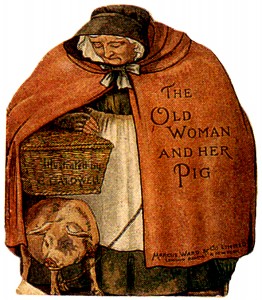 consists of, while the back flap pushes signing up to receive books monthly. The front cover is bold in three colors only, and you need to search for the author’s name which is circling the large head. The front flap gives the reader a synopsis, but already the potential customer is imagining all sorts of dastardly deeds from the abstract art. Now, saying all this, you’d then think one of my very favorites must belong to the Crime Club. And although practically every cover stands out and is amazing, I couldn’t pick just one, therefore I don’t have one in my top favorites.
consists of, while the back flap pushes signing up to receive books monthly. The front cover is bold in three colors only, and you need to search for the author’s name which is circling the large head. The front flap gives the reader a synopsis, but already the potential customer is imagining all sorts of dastardly deeds from the abstract art. Now, saying all this, you’d then think one of my very favorites must belong to the Crime Club. And although practically every cover stands out and is amazing, I couldn’t pick just one, therefore I don’t have one in my top favorites.
 I thought I’d put together an informal grouping of some of the best dust jackets and paperbacks in my collection, and the best book covers that I’ve seen but don’t own. Naturally it is subjective, but that’s what book artwork is all about–pulling a person into the imaginative world of both artist and writer with the reader interpreting what they want from the art. My favorite period of cover artwork is the Art Deco of the 20s and 30s. Whether it be children’s fairy tales, Mother Goose, or even primers, this particular style appeals to me. Many Golden Age crime fiction titles have perfect examples of the Deco style . I am also enamored with the exaggerated style both Dell Mapbacks and Popular Library paperbacks had–different from each other, for sure, but both compelling in their own ways. Each paperback illustrator had a very specific style of their own, and you can pick out which covers were created by what artists if you really decide to study them.
I thought I’d put together an informal grouping of some of the best dust jackets and paperbacks in my collection, and the best book covers that I’ve seen but don’t own. Naturally it is subjective, but that’s what book artwork is all about–pulling a person into the imaginative world of both artist and writer with the reader interpreting what they want from the art. My favorite period of cover artwork is the Art Deco of the 20s and 30s. Whether it be children’s fairy tales, Mother Goose, or even primers, this particular style appeals to me. Many Golden Age crime fiction titles have perfect examples of the Deco style . I am also enamored with the exaggerated style both Dell Mapbacks and Popular Library paperbacks had–different from each other, for sure, but both compelling in their own ways. Each paperback illustrator had a very specific style of their own, and you can pick out which covers were created by what artists if you really decide to study them.
Stunning delicate lines and washes of color highlight illustrator Virginia Sterrett’s French Fairy Tales front cover. No dust jacket, but the pasted on illustration of a fairy and a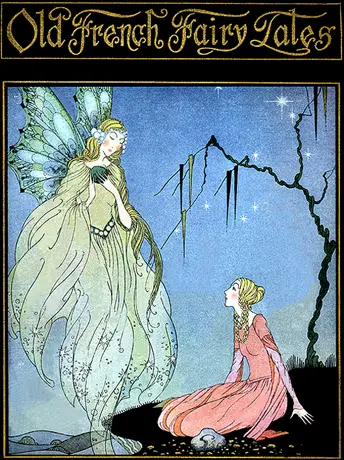 young girl shimmers radiance, and evokes exactly what the author was looking for, beautiful fantasy. The ethereal otherworldly impression the artwork engenders has you entering the realm of fairy kingdoms without having cracked the spine. The interior illustrations are equally sublime. Even if lacking interior plates, the cover alone would make the book worth owning. Sterrett illustrated but three books before she died extremely young of tuberculoiouz.
young girl shimmers radiance, and evokes exactly what the author was looking for, beautiful fantasy. The ethereal otherworldly impression the artwork engenders has you entering the realm of fairy kingdoms without having cracked the spine. The interior illustrations are equally sublime. Even if lacking interior plates, the cover alone would make the book worth owning. Sterrett illustrated but three books before she died extremely young of tuberculoiouz.
Although Art Deco is my favorite style of illustration on books, I can and do love other types. A favorite Victorian piece is a shape book depicting an old lady going to market with her pig, appropriately entitled, The Old Woman and Her Pig. Color limited to low key brown and orange the illustration manages to convey how much the old woman loves her pig, just in the way her head is bowed.
Maman-Cabas has very different interpretation of the age old Mother Goose nursery rhymes. I’ve not had the luck of seeing this book in person, only in a catalog and online. Still is is one if my favorites because of the offbeat background stripes and BATS! Plus owls frame a small section at top, and bat faces, or gargoyles of some sort appear on the bottom. Mother Goose seems just as sweet and cuddly, except perhaps for her admonishing finger and opaque glasses!
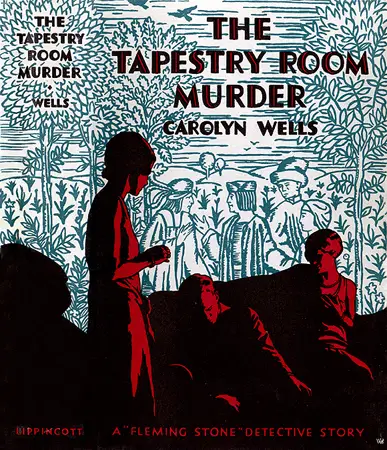 Lippincott published what I believe to be a totally underrated and ignored masterpiece cover. The Tapestry Room Murder is subtle in its call to the reader, but call it does. At first the eye only sees the tapestry on the wall in the background, and maybe the silhouette of the woman on the left, after awhile though, you notice a slumped figure on the couch cast in shadows, which can only bode badly for that individual. Would someone be inclined to read this book, after transporting themselves into that cosy 1920s living room? I certainly would. And if the other Carolyn Wells books are any indication of this one’s literary value, then the artist has committed false advertising!
Lippincott published what I believe to be a totally underrated and ignored masterpiece cover. The Tapestry Room Murder is subtle in its call to the reader, but call it does. At first the eye only sees the tapestry on the wall in the background, and maybe the silhouette of the woman on the left, after awhile though, you notice a slumped figure on the couch cast in shadows, which can only bode badly for that individual. Would someone be inclined to read this book, after transporting themselves into that cosy 1920s living room? I certainly would. And if the other Carolyn Wells books are any indication of this one’s literary value, then the artist has committed false advertising!
Halloween Homicide has all manner of costumed revelers–which are a delight to the eye, especially with light pink , not a typical color associated with murder. Having read the book, if there are merry makers in the story, they whizzed past me.. Doesn’t matter–the artwork did its job–it promises a holiday of reading treats.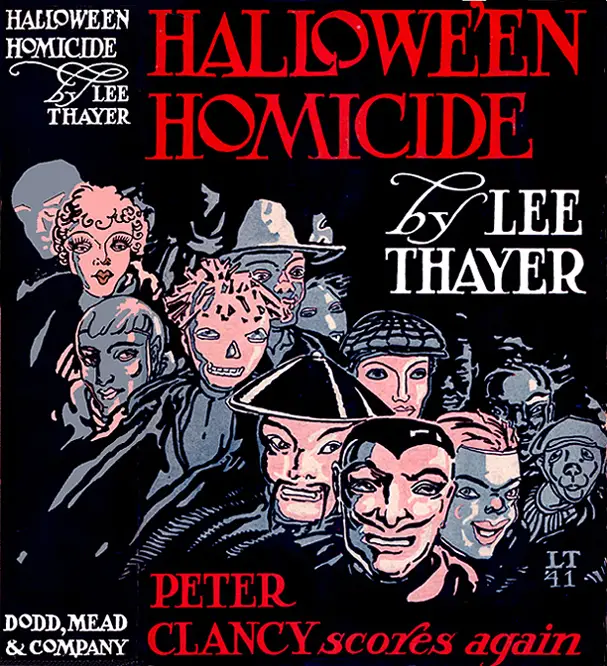
There’s no subtlety involved in The Mad Hatter Mystery–one look says it all. The crazed eyes of a killer stare at you at nose level, and the gigantic top hat commands the rest of the cover. I’m an Alice in Wonderland fanatic, and there are many like me who flip over this version of artwork on a cover, plus Popular Library’s more insane Daliesque rendering. Again, the book bears little resemblance to what the cover promises–actually, I’ve tried to read it so many times butt couldn’t get past the first chapter, I’ve given up.
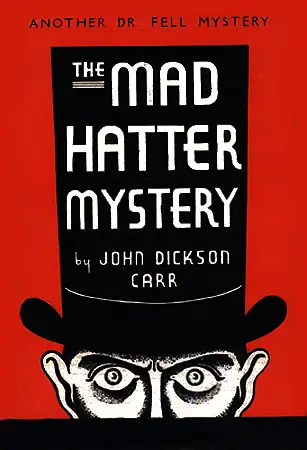 Speaking of crazies, my next favorite is a wild one and very unlike my usual taste. The Little Boy Laughed is almost neon in color with only snippets of pictures. This cover creeps out and unsettles most people I’ve shown it to. And trust me, the cover is perfect! The story-line has to be read to understand how sinister and unsavory that puce kid on the cover is, and the reader is certainly not disappointed by content this time. They may feel they weren’t warned ENOUGH by the artist!
Speaking of crazies, my next favorite is a wild one and very unlike my usual taste. The Little Boy Laughed is almost neon in color with only snippets of pictures. This cover creeps out and unsettles most people I’ve shown it to. And trust me, the cover is perfect! The story-line has to be read to understand how sinister and unsavory that puce kid on the cover is, and the reader is certainly not disappointed by content this time. They may feel they weren’t warned ENOUGH by the artist!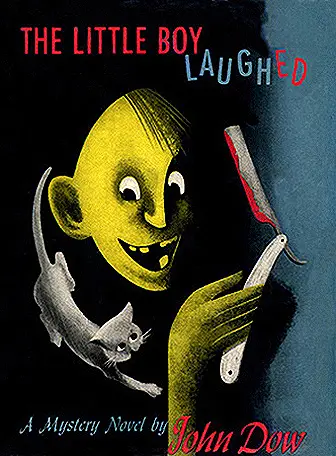
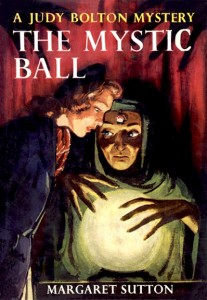 Judy Bolton is an almost forgotten peer of Nancy Drew, which is a deep shame. The Bolton titles are richer, more democratic and socially conscious, and to a good point, realistic in nature. Based on the author Margaret Sutton’s home town, Judy is allowed to mature and grow into an adult. I remembered a certain cover from reading the book as a kid, and when I came across it as an adult, there was no question I needed to own it. The sinister character of the gypsy fortune teller and those large hands reaching out from above excited the juvenile me and opened the door for me to walk through and into Judy Bolton’s mystery, and meet the mysterious woman with The Mystic Ball.
Judy Bolton is an almost forgotten peer of Nancy Drew, which is a deep shame. The Bolton titles are richer, more democratic and socially conscious, and to a good point, realistic in nature. Based on the author Margaret Sutton’s home town, Judy is allowed to mature and grow into an adult. I remembered a certain cover from reading the book as a kid, and when I came across it as an adult, there was no question I needed to own it. The sinister character of the gypsy fortune teller and those large hands reaching out from above excited the juvenile me and opened the door for me to walk through and into Judy Bolton’s mystery, and meet the mysterious woman with The Mystic Ball.
The paperbacks Dell put out starting in the 40s owed almost all of their success to the cover art by various illustrators. There are collectors who know all their names, who did what book, and what other works they were responsible for. I just collect them. Which I started doing as an early teenager, grabbing them at garage sales or flea markets for a dime a piece. The last thing I was interested in was who spun the wicked web of artwork I was nuts about–I only knew that on the back of each book was a colorful wacky map of the scene of the crime, and even though usually not all that specific or correct–the reader was given an extra gift with not only superb offbeat front cover artwork, but a fun game to play figuring out where the murder took place on the back map, and inside–they write up the suspects and players, giving you descriptions of each. A perfect package.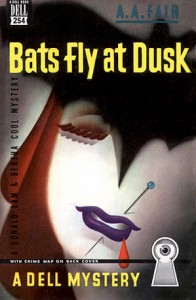
These two are my favorite book covers. The first, Cats Prowl at Night is from a scan I made and worked on eons ago–and not the very best representation of the real thing, but it does in a pinch. Listen, I’ve tried reading the Bertha Cool mysteries from the pen of A. A. Fair, aka, Erle Stanley Gardner, but no dice. Not even gorgeous green cat eyes could make that meal of a book go down. And the creme de la creme, Bats Fly at Dusk just wows me, every time I see it. How twisted! How weird! How absolutely cooler than cool! A bat hat, purple lips, and oh, yes, a hat pin stuck through her lips, just a little detail that somehow stands out, lol. Pure demonic genius!
I hope to explore and delve into specifics about the best book covers and their artists in articles to come. For now, you’ve a little eye candy you can munch on!
The Piccadilly Murder, Mosquitoes, and The Death of Cosmo Revere and The Grapes of Wrath were restored by Mark Terry of Facsimile Dust Jackets LLC. To gaze mesmerized for hours at his stock of available covers, go here: http://www.facsimiledustjackets.com/cgi-bin/fdj455/index.html

Too wonderful for words, Diane, you’ve put together an impressive synopsis of the history of book illustration here. I too, as you know, love book cover art, though my collection does not compare to yours. I thoroughly enjoyed this article and hope lots of our friends from Flickr will be reading this.
I looked into buying some facsimile book covers a while ago but then I was fortunate to find the originals I needed at an affordable price. But while going through the “catalog” of covers that Terry has re-created, I was tempted to buy some, even though I don’t own the books – they are so beautiful!
Nancy–I’m a novice compared to people on flickr who know each and every cover artist’s name, the year it was published, and probably have their baby footprints somewhere, lol.
Oh, I bought a couple of his jackets and put them on whatever book I have that will pass–just because the art is so splendiferous. One of the jackets is sooooo cool, I wanted a tee shirt made, but the darn husband hasn’t obliged!
I love book cover art,it tells the story before you read it in its own unique way. Thank you for putting up a very interesting article on the history of these book cover art. I have really enjoyed this little eye candy and have munched it all, can’t wait for he second helping!
The old woman and her pig is my favourite, it’s a state of art!